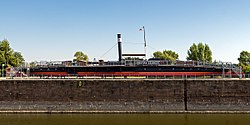Gustav Zeuner (ship)
|
Berth next to the harbor basin
|
||||||||||||||
|
||||||||||||||
|
||||||||||||||
|
||||||||||||||
The Gustav Zeuner chain steamer was built in 1894 as the first chain tow steamer of the second generation in the Übigau shipyard near Dresden . The ship is the only almost completely preserved relic of chain shipping on the Elbe . The ship was in service on the Elbe from 1895 to 1931 and is now a museum ship in the Magdeburg trading port . It is named after the German engineer Gustav Zeuner .
history
As industrialization progressed , bulk freight traffic on the Elbe increased rapidly. The paddle steamers with low - pressure steam engines used up to then were too inefficient. In order to improve the tugboat transport system, new tugs were now being sought. At that time, the required performance could only be provided by chain tractors.
The first concrete steps towards the introduction of chain shipping in Germany were taken on the Rhine and Elbe since 1862/1863 . The chain navigation on the Elbe and Saale began with the first, regular towing a steamer chain in Magdeburg on the portion of the same between Magdeburg-Neustadt and Magdeburg-Buckau realized. The realization of the line expansion to Hamburg lasted until 1874. In 1871 the line to the Upper Elbe, to the village of Kreinitz , was laid out. By 1873 the KSO (chain towing ship Upper Elbe) had 13 chain steamers. In the Saale , too, 105 km of chain were laid from the estuary to Halle by 1903.
The ship
The iron and fully riveted chain steamer was built in Übigau from 1894 to 1895 and put into service there in 1895. The second generation ship was equipped with a groundbreaking technical innovation, the " Bellingrath chain gripper wheel " with a diameter of 2320 mm. It also had two water jet turbines, far ahead of its time, connected to the main engine via detachable couplings to improve maneuverability while driving on the chain and for problem-free and independent driving without a chain. These water jet turbines, an invention of Gustav Zeuner, who gave the ship its name, can be seen as the preliminary stage of modern water jet propulsion . One of the most important items of equipment was the towing gear with two tow ropes and two steam winches. A stable tow hook as well as an anchor and hand anchor winches at the bow and stern were also part of a smooth towing operation. Dragges with four flukes , which were common in inland navigation at the time, were used as anchors . After 1918 the hand wheel was replaced by chain drums .
crew
As a rule, the crew consisted of the master, a machinist, two stokers and two boatmen.
Whereabouts
After chain shipping on the Elbe was discontinued and the chain steamer Gustav Zeuner was decommissioned in 1931, the hull of the ship experienced very different uses. Among other things, it was sold to Paul Michaelis in Magdeburg-Fermersleben in 1933 , put on land, provided with wooden deck superstructures and used as a sports boat shed and restaurant. The ship was in the area of the port of Fermersleben , a little south of the port on the west bank of the Elbe. With the help of a cable car, paddle boats under the chain steamers were transported to the Elbe. The use of the chain steamer, on which amusement events also took place on the weekends, experienced another high point in the mid-1960s, but was later discontinued. The hull was left to decay. In 1988 the preserved hull was placed under monument protection.
According to newspaper reports in the Magdeburger Volksstimme of July 9th and 14th, 2005, the Gustav Zeuner should be rescued and made buoyant through a job creation measure and various other contributors and used as a museum ship. After clearing and dismantling into sections and a transport to the Magdeburg Science Harbor (formerly trading port ), the detailed reconstruction and restoration by the "Society for Innovation, Sanitation and Disposal (GISE mbH)" in cooperation with the "Jobcenter ARGE Magdeburg mbH" and the support of the city of Magdeburg are started. The work was completed at the end of September 2010.
On November 11, 2010, the museum ship was handed over in the presence of the Mayor of Magdeburg, Lutz Trümper . The ship was not made buoyant. The permanent exhibition site is located next to the harbor basin, in the immediate vicinity of other historical, floating devices and structures, such as a historical bucket-chain floating excavator and diving shaft II . In addition to many different wagons and locomotives from different years of construction, there is also a historic lift bridge and storage building. The Gustav Zeuner can be visited in the summer months from Wednesdays to Sundays free of charge as part of guided tours. In the first season, over 5200 guests visited the newly renovated museum steamer.
Web links
- Website Kettenschleppdampfer Gustav Zeuner , Official website for the chain tow steamer Gustav Zeuner, accessed on June 4, 2011
- Introduced: the chain tow steamer "Gustav Zeuner". In: M hoch 3. Offener Kanal Magdeburg, 2011, accessed on September 5, 2016 .
Individual evidence
- ↑ 20 minutes Magdeburg; 1st year / 44. Week; Edition of November 6, 2010 page 1
- ↑ Heinz Tietge, The Buckau-Fermersleben Water Sports Association , Part 1 1911–1961, Magdeburg 2011, page 122 ff.
- ↑ “Gustav Zeuner” chain tow steamer shines in new splendor magdeburgersonntag.info November 11, 2010
- ^ Karl-Heinz Kaiser: The "Gustav Zeuner" on the road to success: Restored chain steamer already had 5200 visitors on board , Magdeburg Volksstimme on October 28, 2011
Coordinates: 52 ° 8 ′ 56.1 ″ N , 11 ° 39 ′ 43.1 ″ E






